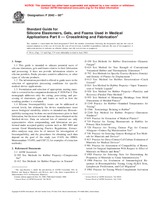We need your consent to use the individual data so that you can see information about your interests, among other things. Click "OK" to give your consent.
ASTM F2042-00e1
Standard Guide for Silicone Elastomers, Gels, and Foams Used in Medical Applications Part II - Crosslinking and Fabrication (Includes all amendments And changes 8/16/2017).
Automatically translated name:
Standard Guide for Silicone Elastomers, Gels, and Foams Used in Medical Applications Part II - Crosslinking and Fabrication
STANDARD published on 10.7.2000
The information about the standard:
Designation standards: ASTM F2042-00e1
Note: WITHDRAWN
Publication date standards: 10.7.2000
SKU: NS-52563
The number of pages: 7
Approximate weight : 21 g (0.05 lbs)
Country: American technical standard
Category: Technical standards ASTM
Annotation of standard text ASTM F2042-00e1 :
Keywords:
foam, gel, high consistency rubber, liquid silicone rubber, medical device material, moisture cure, peroxide cure, platinum cure, RTV, ICS Number Code 11.040.40 (Implants for surgery, prothetics and orthotics)
Additional information
| 1. Scope | ||||||||||||||||||||||||||||||||||||||||||||||||||||
|
1.1 This guide is intended to educate potential users of silicone elastomers, gels and foams relative to their fabrication and processing. It does not provide information relative to silicone powders, fluids, pressure sensitive adhesives, or other types of silicone products. 1.2 The information provided is offered to guide users in the selection of appropriate processing conditions for specific medical device applications. 1.3 Formulation and selection of appropriate starting materials is covered in the companion document, F 2038 Part I. This monograph addresses only the curing, post-curing, and processing of elastomers, gels and foams as well as how the resulting product is evaluated. 1.4 Silicone biocompatibility issues can be addressed at several levels, but ultimately the device manufacturer must assess biological suitability relative to intended use. Biocompatibility testing may be done on cured elastomers prior to final fabrication, but the most relevant data are those obtained on the finished device. Data on selected lots of material are only representative when compounding, and fabrication are performed under accepted quality systems such as ISO 9001 and current Good Manufacturing Practice Regulations. Extractables analyses may also be of interest for investigation of biocompatibility, and the procedures for obtaining such data depend on the goal of the study (see F619, the HIMA Memorandum 7/14/93, and USP 23, for examples of extraction methods). |
||||||||||||||||||||||||||||||||||||||||||||||||||||
| 2. Referenced Documents | ||||||||||||||||||||||||||||||||||||||||||||||||||||
|
We recommend:
Technical standards updating
Do you want to make sure you use only the valid technical standards?
We can offer you a solution which will provide you a monthly overview concerning the updating of standards which you use.
Would you like to know more? Look at this page.




 Cookies
Cookies
